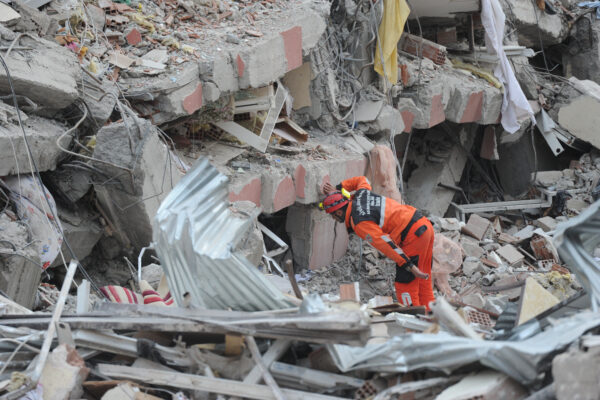For the city of Aleppo (Syria), there has persisted an age-old pattern of being caught in crossfire, razed to the ground, and fully reviving.
For the city of Aleppo (Syria), there has persisted an age-old pattern of being caught in crossfire, razed to the ground, and fully reviving.
Does history repeat itself? There are several problems with this popular expression, but history certainly follows some patterns. For the city of Aleppo (Syria), there has persisted an age-old pattern of being caught in crossfire, razed to the ground, and fully reviving. And while it’s certainly wrong to trivialize the current tragedy unfolding in Aleppo or to say that it was inevitable, looking back at the history of this city nonetheless gives us hope that Aleppo will one day fully revive itself. The question to ask is whether you and I will be active contributors or passive bystanders in that revival.
Aleppo is one the most ancient cities in the world. The first mention of Aleppo that we know of is from 4000 years ago, and it suggests that the city already had a long history at that point. It must have started out as a village in prehistoric times and, due to its abundance of natural resources and easily-defensible position, gradually become dominant in the region. It had peaceful relations with the powerful Hittites of Anatolia, but the relationship soured and the Hittites pillaged the city in the late 3900s BCE. It was conquered by another local dynasty around 1650 BCE, and fell to the Hittites again 200 years later. These conflicts left the city in ruins, so much that it didn’t play a prominent role in Assyrian and Persian dominance in the region that followed.
Aleppo would remain an insignificant rural town for nearly a thousand years. In 333 BCE, Alexander of Macedon conquered the city. One of Alexander’s generals, Seleucus Nicator, redesigned and rebuilt Aleppo (which the Macedonians called Beroia) and made it the capital of his dynasty, the Seleucid Empire. The Seleucids ruled Aleppo until 88 BCE, when it was briefly occupied by Tigranes II and briefly became part of the Kingdom of Armenia. Tigranes was soon defeated by the Romans, who took control of Aleppo in 64 BCE and ushered in a long period of stability for its residents. It was at this time that small communities of Arabs, Jews and early Christians began to establish themselves in the city.
The Persian invasion of Syria in 540 CE led to most of Aleppo being razed to the ground. The famous Byzantine emperor Justinian rebuilt part of the city, but the constant thread posed by the Persians blocked off efforts to fully restore the city. In 636, a Muslim army led by Khalid ibn al-Walid appeared outside the city; the Arabs of the city surrendered without a fight, followed by the rest of the inhabitants. The overall commander of the Muslims, Abu Ubaydah ibn al-Jarrah, offered Aleppo’s residents favorable terms of surrender, which they accepted. The first mosque in Aleppo was built soon afterwards.
The Muslim presence in Aleppo developed slowly, in part because it was not a center of power for either the Umayyads or the Abbasids. It was constantly fought over by local dynasties, such as the Egypt-based Tulunids. In 944, Aleppo was captured by the Hamdanid leader Sayf al-Dawlah; the Hamdanids were a Shi‘a dynasty, and Sayf al-Dawlah made Aleppo his capital and the base from which he resisted the Byzantine Empire’s attempts to re-conquer Syria. His court in Aleppo also became a center for Arabic literary culture. However, the Hamdanids were unable to defend Aleppo; in 962, Nicephorus II and the Byzantine army suddenly appeared at Aleppo, besieged the city, and spent a week burning it to the ground.
The Fatimids, another Shi‘a dynasty, were next to take over Aleppo, in 1015. However, their grip on the city was not firm, and they soon gave it to the local Mirdasid dynasty to rule on their behalf. The Fatimids and Byzantines regularly interfered in Aleppo’s affairs, weakening the city. The Seljuks soon became involved in the “Great Game” over Aleppo as well, and the confusion was soon joined by the Crusaders, who laid siege to the city in 1098 and 1124 but were unable to conquer it. But the city’s destruction soon came from another source. On August 9, 1138, a deadly earthquake devastated the city; an estimated 230,000 people in the region were killed, making it one the deadliest earthquakes in human history.
In 1129, Aleppo had come under the control of Imad ad-Din Zangi, the founder of the Zangid dynasty. The Zangids would play a crucial role in reviving the city, repairing infrastructure, encouraging trade, setting up hospitals and courts, and encouraging the teaching of Sunni Islam in a population that had largely been Shi‘a since the time of the Hamdanids. The people of Aleppo resisted Salah ad-Din Ayyubi’s efforts to make the city part of his empire, but eventually handed it over to him as Zangid authority broke down. The Ayyubids, descendants of Salah ad-Din, continued the revival and expansion of Aleppo, to the point that it became one of the most beautiful and active cities in the Middle East. In fact, Aleppo was so prosperous that even merchants from Venice established a factory there.
However, the Ayyubids soon integrated as well, and in 1260 Aleppo was sacked and destroyed once again. This time it happened at the hands of Hulagu Khan and the Mongols. For the next several years, the Mongols and the Egypt-based Mamluks ruthlessly fought over the city. The Mamluks eventually took Aleppo, but the city remained plagued by problems of corruption, the arrival of the Black Death in 1348, and the conquest of the city by Timur. However, as a center of trade and in particular as one endpoint of the Silk Road, Aleppo continued to prosper from the time of the late Mamluks to the end of the Ottoman era in the early 20th century.
By 1520, Aleppo was firmly in Ottoman control. However, the Ottoman-Safavid wars, the city’s distance from Istanbul, and the involvement of the European powers in the city’s economic affairs kept Aleppo on the margins of the Ottoman world. By 1775, the French had established a virtual monopoly on Aleppo’s trade, and between 1831 and 1838 the city was occupied by semi-independent government in Egypt. In 1822, large parts of Aleppo were once again destroyed by a powerful earthquake. Aleppo became important during WWI, as a center for Ottoman defense of the Middle East and as a strategic city for the European imperialists to fight over. After the war, Aleppo became part of the French Mandate of Syria, and later of independent Syria.
And the rest, as they say, is history.
This article was originally published here on iHistory.





